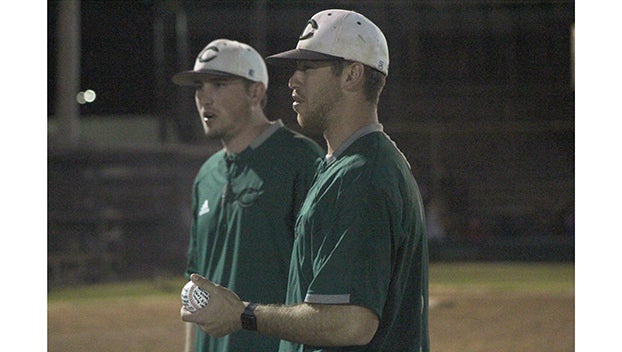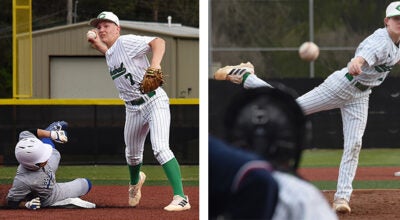Underhand motion in softball is better for arms
Published 12:06 am Sunday, April 1, 2012

Vidalia High School softball pitcher Laura Perilloux works with her father on the proper pitching technique for softball. (Illustration by Lauren Wood)
VIDALIA — Laura Perilloux has a very specific pre-game routine that helps prepare her for a night on the mound.
The Vidalia High School pitcher, like dozens more in the area, wants to ensure her pitching mechanics are without flaw before she faces batters. Like in baseball, softball pitchers live, breathe and log strikeouts through mechanics.
First, Perilloux said she gets close to the catcher and checks the spins on the different types of pitches she throws. Then she goes through half of her windup, called a K-drill, in order to ease herself into the motion. Finally, she stands farther from the plate than she will during the game and starts throwing, which forces her to throw harder than she would during a game and gets her arm ready.
Perilloux said each step is important in preventing bad habits from showing up in a game.
“With my spins, I make sure everything is OK before going to full distance,” Perilloux said. “If there’s something you do wrong during the K-drills, you can notice it then before you go into your full delivery.”
Good mechanics often mean the difference between a strong pitching performance and a poor pitching performance, and they are also key in preventing injury. But, what exactly constitutes good mechanics?
Natural or unnatural?
The underhand motion softball uses is considered a more natural motion than the overhand motion used in baseball. Perilloux’s father, Glen Perilloux, with whom Laura primarily works, said just because softball pitching is safer than baseball, it doesn’t mean it’s totally safe.
“No doubt, these girls will amaze you with how durable they’ll become,” Glen said. “That said, there have been studies out there that (underhand) is not as natural a motion as previously thought. It is better, but you can still get hurt.”
Because of this, Glen said learning proper mechanics at an early age is of the utmost importance. Laura said that’s especially true if a pitcher has college aspirations.
“The further you go, the more important they become,” Laura said. “When you start out young and do it wrong, it will be ingrained into your muscle memory. By the time you get to the age where you want to go to college, if you have bad mechanics, they’re going to pick someone other than you.”
Rut Horne, a softball pitching coach from Ferriday that helps teach local girls how to pitch, said the underhand motion is leaps and bounds better than the overhand motion, in his experience.
“I’ve never had a girl hurt throwing underhand,” Horne said. “Their muscles will get sore, but they’re not having a rotator cuff or elbow injury. They might get blisters, but that’s just something you have to live with. In high school, you generally get them early, then the skin toughens up.”
What makes good mechanics?
Horne said softball pitchers use the windmill motion to pitch, and there are two different kinds of windmills that pitchers primarily use.
In the first kind, the pitcher brings the ball over behind her and then makes the delivery. In the second kind, the ball is presented in front of the pitcher for one second, then she brings it back, rocks back and makes the windmill.
When it comes to teaching new pitchers how to pitch, Horne said he doesn’t like the second motion as much as the first, since the second motion could create inconsistencies in the delivery.
“You could rock back at 6-o’clock, 7-o’clock, eight and nine, then if you’re a young pitcher and you do the windmill at the same speed, who knows where it’s going?” Horne said.
Horne also said he doesn’t like the idea of presenting the ball to the hitter.
“It exposes the grip, and advanced hitters can spot it and know what’s coming,” Horne said. “In the first grip, the glove covers the ball most of the delivery.”
The first thing every pitcher wants to do is generate power behind their pitches, and Horne said a longer stride, or the step coming off the rubber, can add 5 to 8 mph to a fastball.
“If you can throw 60 mph, that’s the magic number,” Horne said. “The exceptional kids can throw it 70 to 72 mph.”
Grip is also important, depending on what kind of pitch is being thrown, Horne said. Most girls hold the ball with three fingers and their thumb for a fastball, he said, and the further out of her hand a pitcher can hold it before throwing, the faster it will be. If she wants to throw a slower pitch, or a changeup, she should bury the ball in her hand, he said.
Horne also said a pitch’s release point is important, but he said there isn’t a universal method to teaching the proper release point.
“I’d hate to try to teach someone exactly when to release the ball,” Horne said. “That’s a function of the individual stride and how far out they hold the ball. If they throw five days a week, they’ll figure out where that sweet spot is.”
Cathedral pitcher Mollie Devening, who works with Horne, said the release point makes all the difference when it comes to locating the ball.
“You try to release the ball at your hip,” Devening said. “You have to practice it a lot to make it consistent. If you let it go too early, it’ll go too low. If you let it go too late, it’ll go too high.”
Rise ball or no?
Most pitchers want to have a big arsenal of pitches, and they especially want to throw the rise ball, Glen said.
A rise ball works by using a certain grip during the throw that causes the ball to rise into the strike zone. Since the pitch is so complex to learn and requires a certain speed, Glen said he wouldn’t recommend teaching the pitch until at least age 14.
“It can’t truly be effective until you get to about middle 50s on velocity, and most girls have plenty to work on as far as fundamentals and basics,” Glen said.
Horne said of all the pitches a softball player can throw, the rise ball is the hardest.
“You have to put pure back spin on the ball,” Horne said. “The grip is a split-finger grip, and the movement on the ball is all about the spin.”
Cathedral senior Ginny Dagget, who learned the rise ball from Horne, she was glad she fought through the difficulty in learning it.
“When I first started learning, there we so many things you had to do,” Daggett said. “It took so much out of me, but once I learned it, I loved the feel.”
How do you avoid bad mechanics?
Glen said there are certain throwing motions that are incorrect, which could potentially lead to injury if not corrected.
“If you see your daughter get away from her body or behind her body (delivering the pitch), then you need to stop her,” Glen said. “That’s when the shoulder can be hurt, and you can get elbow problems.”
The biggest test, though, is simply paying attention to what your child says, Glen said.
“Listen to your daughter. If during any pitch or any drill she says it hurts, always stop,” Glen said.




